Floor Cleaning Mops are one of the essential cleaning arsenals required for day-to-day floor cleaning of your homes, offices, and other commercial spaces. After all, damp mopping is best for removing tough stains, spots, and grit, as well as deep cleaning of the floors. But, cleaning the floors with a sitting and mopping (Bucket and Cloth) method is a thing of the past, as we now have a range of unique mops available for different cleaning tasks.
These floor cleaning mops don’t strain your hands, knees, and back. In addition, mopping this way is less messy since there is no need to squeeze dirty and excess water from the mop as you do in traditional mopping. Above all, these floor mops will provide you with a quick, effortless, and easy mopping experience.
In this post, we’ll explore the different types of floor mops and their uses, so you may know better which one is right for your floor cleaning needs.
Types of Floor Mops Explained
1. String Mops
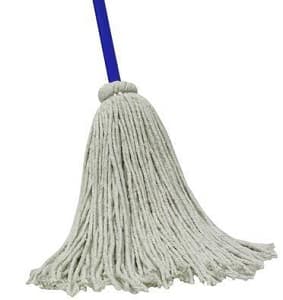
The string mops are the most popular types of floor mops that come with an elongated rod and looped cotton strings attached at the front. They offer powerful scrubbing on the floor to remove stains and spots; plus, their higher absorbency makes them a great choice for general cleaning.
The string mops are very durable and clean bigger messes with ease. To use them, you need a bucket of cleaning solution and water to wring out the mop in it for cleaning.
Some models come with a detachable mop head that you can wash in a washing machine for easy cleaning and maintenance.
Pros
- Highly absorbing and scrubbing capacity
- Suitable for cleaning larger spaces
- Mop heads are machine washable
- Budget-friendly
Cons
- The strings of these mops tend to fall apart more quickly
- Difficult to clean and maintain if the mop head is not detachable
- Need to be dried properly, otherwise tends to mold, and bacteria build-up
- Leaves wet spots on floors
2. Strip Mops
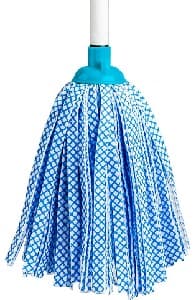
The strip mops are much similar to the string mops, but instead of cotton strings, they come with fabric strips. These mops are ideal for both wet and dry cleaning. You can use them for general dusting when they are dry, and for damp mopping, you can use them the same way as string mops.
They are super absorbent and dry your floor very quickly, leaving no wet spots behind. Even more, they are very easy to clean and maintain as the detachable mop head is machine washable. And since the mop heads dry out very quickly, there are less or no chances of fungal growth that results in a stinky odor.
Pros
- Can be used for wet and dry cleaning of floors
- Removable and reusable heads
- Easy to clean and maintain the mop heads
- Suitable for homes and offices
- Leaves no patches and wet spots on floors after mopping
- Less expensive
Cons
- Scrubbing power is not as effective as other types of floor mops.
3. Flat Mops
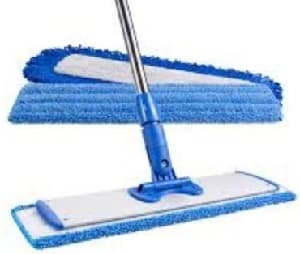
As the name suggests, flat mops have an elongated rod handle and a flat head with disposable or reusable padding attached for mopping the floor. These are the most common types of floor mops that are used for both dry and wet mopping.
The flat mops, due to their shape and design, can easily clean the dirt, grime, stains, and spots from the floors and are best to use on hardwood and vinyl flooring. Even more, they can easily reach intricate spots like corners and crevices.
Some of the high-end flat mops come with onboard chemical dispensers on the handle of the mop that holds the cleaning solution. You need to pull the lever to dispense the chemical directly to the floor for mopping uses. Thus, it eliminates the need for a mop bucket (full of water and cleaning solution).
Pros
- Reusable and disposable mop padding
- Suitable for both wet and dry cleaning
- Some advanced models can rotate 360 degrees for better accessibility.
- Multipurpose mop, since the microfiber padding can also be used to clean glass windows and bathroom wall tiles.
- No risk of cross-contamination as you don’t need to dip the dirty mop into a bucket of cleaning solution.
Cons
- Not ideal for cleaning big spaces
Check here for The Best Flat Mops
4. Sponge Mops
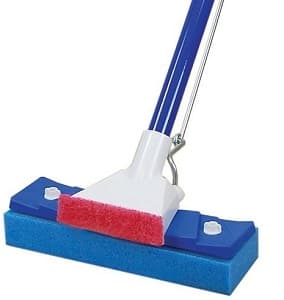
The sponge mops are very popular for their highly absorbent capacity. They come with a spongy frontal head attached to a long rod for easy cleaning of liquid spills like soups, juices, etc.
These mops are very easy to use since they don’t require much pressure to scrub the spots. In addition, they have removable heads for easy rinsing and replacement when needed.
Since the sponge mops tend to catch bacteria with ease, their proper care and maintenance are very important. So, you need to rinse the mop head after every use and place it in an upright position to let it completely dry. This will avoid the spread of bacteria, so next time when you use it, you will not feel any foul smell or stink while mopping.
Also, if you see the sponge of the mop head is breaking apart, replace it with a newer one to get the best cleaning results.
Pros
- They work well on tile and other hard floorings
- Extremely easy to use
- Highly absorbent
- Replaceable mop heads
Cons
- Gets heavier after absorbing the liquids
5. Spin Mops
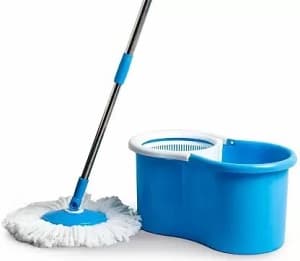
Spin mops are highly popular and more in demand due to their ease and convenience of use, nice accessibility to hard-to-reach spots, and budget-friendly price. They are one of the finest categories among mops with buckets available on the market.
The design includes an extended rod with a string mop head that spins out to clean stubborn stains and spots from the floor. In addition, it comes with a bucket too with two chambers in it- one for clean water and soapy solution and the other with a spinner to easily clean the fibers of the mop.
Pros
- Good to eliminate the toughest stains and spots on floors with their spinning action
- Cleans faster than other types of floor mops
- The telescopic handle extends your cleaning reach.
- Best for cleaning tricky and hard-to-reach spots
- Suitable for both home and commercial places
Cons
- Deposit dirt back into the soapy water solution when you rinse it
6. Dust Mops
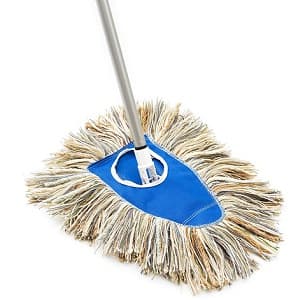
Dust mops are the dry mops that are used for cleaning of dust, sand, and other dry dirt from the floors. You can also use them after wet mopping to dry out the floors more quickly. These mops are pretty more easy and convenient than standard brooms as well as broom and dustpan sets. They easily glide across the floor, picking up dirt and dust and tidying up the floors very quickly.
Pros
- Best for cleaning floors, walls, and ceilings
- The long handles reach easily to clean cobwebs, ceiling fan blades, window blinds, etc.
- Can be used after wet mopping to avoid water spots on the floor
- Suitable for large offices, schools, etc.
Cons
- It doesn’t clean stubborn stains and spots from the floor due to the lack of wet mopping.
7. Steam Mops
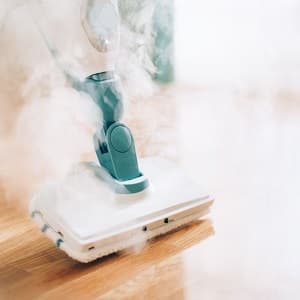
If you want a device that not only mops your floor but also disinfects it, investing in steam mops is the ideal solution. These mops run on electricity and come with a water tank. When you switch it on, it releases steam via the mop head to remove stubborn stains and spots from the floor and kills bacteria and germs. The best part is that these mops are ideal for both floor and carpet cleaning.
Pros
- Good for tough stains and spots as the steam loses grime before the mop head absorbs it.
- Mops and sanitizes the floor at the same time
- Reusable and replaceable mopping pad
- Requires very minimal effort in scrubbing
- Can clean tile, floors, carpets, and even draperies.
Cons
- Require electricity or battery to run
- Expensive
8. Robot Mops
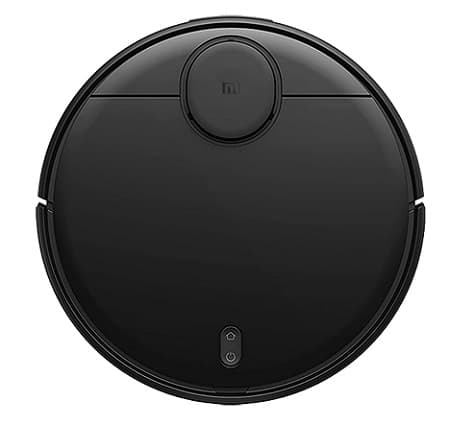
The development of autonomous technology has led to the creation of robotic devices for a variety of purposes, including for cleaning floors and robot mops are one of the best amongst them. The use of robot mops has been growing in popularity due to the many benefits they offer over traditional manual mopping. Not to mention, they are incredibly convenient. Simply set them up to run on a schedule that works for you, and let them do the dirty work!
Because they are autonomous, you no longer need to bend, stoop, or reach to operate them, which can help reduce the risk of back pain, carpal tunnel, and other musculoskeletal disorders.
The robot mops have a built-in water tank (as well as a vacuuming feature), and they use advanced sensors to target dirt and grime more effectively.
Pros
- Hands-free mopping
- The hybrid models support vacuuming as well as dry and wet mopping
- Works well on multiple floor types, including carpets
- Can be scheduled to do their job if you are away from home
- Can boost the cleaning with the right mode
Cons
- Expensive over other types of floor mops
- Sometimes stuck between furniture and other obstacles
- You can’t use cleaning solution in it as it may damage the machine
Read Next: The Best Spin Broom Floor Sweepers for Indoor and Outdoor Cleaning (2022)